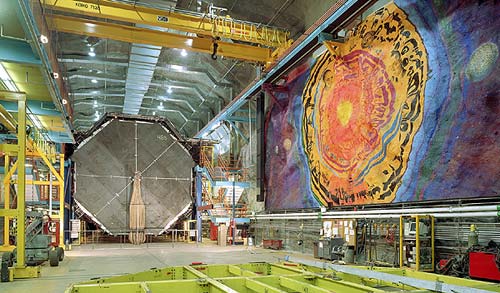Tiny Neutrinos May Hold Link to Understanding More of the Universe
Officials at the Department of Energy's Fermi National Accelerator Laboratory today dedicated the MINOS experiment and the beam that will send subatomic particles called neutrinos from Fermilab, near Chicago, to a particle detector in Minnesota. The Honorable J. Dennis Hastert Jr., Speaker of the U.S. House of Representatives, and Dr. Raymond L. Orbach, Director of the DOE Office of Science, officially inaugurated the Main Injector Neutrino Oscillation Search (MINOS) experiment. The Speaker activated the beam to send the first pulses of neutrinos on a path through the earth from Fermilab to a detector located 450 miles away, a half-mile underground in the historic Soudan Iron Mine in northeastern of Minnesota (Soudan, Minnesota).

Assistant Professor Alec Habig, UMD Physics, is among a group of 200 scientists studying these subatomic particles (neutrinos) from space, to see if they can uncover how these particles are made and explain what happens to them on their way here. In Minnesota, a 6,000-ton particle detector will search for neutrinos that may have changed from one kind to another during the 2.5-millisecond trip from Chicago to Soudan, Minnesota.
Trillions of lab-created neutrinos will pass through the MINOS detector each year. But because neutrinos interact so rarely, only about 1,500 of them each year will collide with atoms inside the detector. The rest pass right through with no effect. MINOS scientists will use the change from one type of neutrino to another as the key to discovering neutrinos' secrets.
"In time, the MINOS Project will be viewed as a landmark event in the history of physics. This world-class research is a bold, visionary initiative which will have profound implications for our understanding of the structure and evolution of the universe," said Congressman James L. Oberstar, whose Minnesota district includes the Soudan site. "The billion-year-old rock formations in the Soudan Underground mine, which is located in my congressional district, has provided some of the world's richest iron ore. Now it may help unlock mysteries about the origins of the universe. I congratulate Dr. Earl Peterson (Director of the underground laboratory), the University of Minnesota, Fermilab, and the U.S. Department of Energy for being at the forefront of scientific research and discovery."
The Neutrinos at the Main Injector (NuMI) project, with the MINOS experiment, includes over 200 scientists, engineers, technical specialists and students from 32 institutions in 6 countries, including Brazil, France, Greece, Russia, the United Kingdom and the United States. The institutions include universities and national laboratories. The U.S. Department of Energy provides the major share of the funding, with additional funding from the U.S. National Science Foundation and from the United Kingdom's Particle Physics and Astronomy Research Council.
Generating the neutrinos destined for Minnesota required building a beamline housed underground at Fermilab. The beamline is a 4,000-foot tunnel, whose direction, roughly north and slightly down, points from Fermilab to Soudan. The beamline tunnel holds the components which generate the neutrinos from protons accelerated by Fermilab's Main Injector. Then comes the MINOS Hall, a 120-foot-long cavern located 350 feet below the surface of the lab campus, with access by an elevator traveling the equivalent of a 30-story building. The MINOS Hall holds the near detector, a smaller version of the MINOS detector at Soudan, which is used to measure the properties of the neutrinos at the start of their trip to northern Minnesota.
"Physicists from around the world are trying to understand what these mysterious neutrinos are telling us," said Fermilab director Michael Witherell. "Today, we are embarking on a journey of exploration using the most powerful neutrino facility in the world. I am extremely proud of what the people of Fermilab have accomplished in completing the NuMI project. I would like to thank the American people and the federal government for making the necessary commitment to support great science."
Michael Turner, the National Science Foundation's Assistant Director for Mathematics and the Physical Sciences, believes the neutrinos' infinitesimal mass belies their significant and ubiquitous impact.
"Neutrinos are always referred to as ghostly particles, as if they are of little interest and have to be apologized for," Turner said. "Nothing could be further from the truth. Neutrinos account for as much of the mass of the universe as do stars, they play a crucial role in the production of the chemical elements in the explosions of stars, and they may well explain the origin of the neutrons, protons and electrons that are the building blocks of all the atoms in the universe. MINOS will help us better understand how neutrinos shaped the universe we live in."
Fermi National Accelerator Laboratory, founded in 1967, is a Department of Energy National Laboratory in Batavia, Illinois, about 40 miles west of Chicago. Fermilab operates the world's highest-energy particle accelerator, the Tevatron, on its 6,800-acre campus. About 2,500 physicists from universities and laboratories around the world do physics experiments using Fermilab's accelerators to discover what the universe is made of and how it works. Discoveries at Fermilab have resulted in remarkable new insights into the nature of the world around us. Fermilab is operated by Universities Research Association, Inc. a consortium of 90 research universities, for the United States Department of Energy, which owns the laboratory.
For more information, please visit:
Photos are available at:
http://www.fnal.gov/pub/presspass/press_releases/NuMI_photos/
More information on the NuMI/MINOS project is at:
http://www-numi.fnal.gov/
Choose appearance:
[ Desktop
| Mobile friendly ]